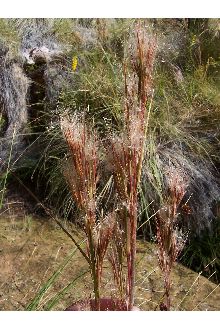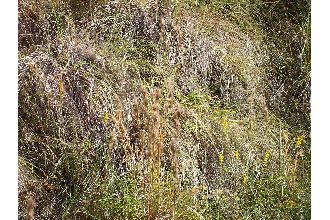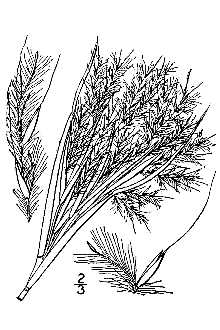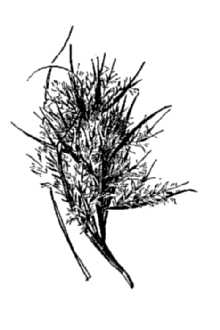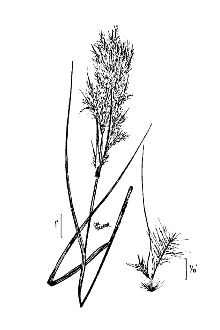Bushy Bluestem
Scientific Name: Andropogon glomeratus (Walter) Britton, Sterns & Poggenb.
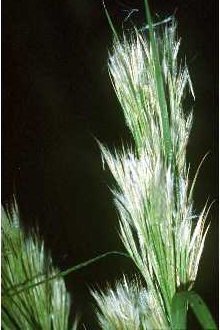
| General Information | |
|---|---|
| Usda Symbol | ANGL2 |
| Group | Monocot |
| Life Cycle | Perennial |
| Growth Habits | Graminoid |
| Native Locations | ANGL2 |
Plant Guide
Alternative Names
bushy bluestem, bushy broomsedge, lowland broomsedge, and bushybeard bluestem. Some botanists consider Andropogon glomeratus and Andropogon virginicus as one species. However, the two grasses are distinct and consistent in appearance and are currently recognized as separate species.
Uses
Livestock: Although it rates low as a forage grass, bushy beardgrass can be used as forage during the summer, fall, and winter months; however, it is more palatable during the early spring. The palatability is increased after a late winter burning. Ornamental Landscaping: Bushy beardgrass is used as an ornamental grass in landscapes because of its showy plumes that turn a rust color during late fall and early winter. It is recommended for golf courses, around pond edges, stream banks and other wet sites. Wildlife: Bushy beardgrass benefits wildlife. The finch, junco, and tree sparrow eat the seeds. The white-tailed deer and rabbits browse the plant. Bushy beardgrass also provides cover for mottled ducks and fawns (white-tailed deer). Grass Images @ Texas A&M University Conservation Practices: Bushy beardgrass, because of its growth habit, potentially has application when established with the following conservation practices; however, conservation practice standards vary by state. For localized information, consult your local NRCS Field Office. NRCS practices include the following: 327-Conservation Cover; 386-Field Border; 390-Riparian Herbaceous Cover; 393-Filter Strip; 512-Pasture and Hay Planting; 550-
Range
Planting; 560-Access Road; 562-Recreation Area Improvement; 643-Restoration and Management of Declining Habitats; 644-Wetland Wildlife
Habitat
Management; 647-Early Successional Habitat Development/Management; 656-Constructed Wetland; 657-Wetland Restoration; 658-Wetland Creation; 659-Wetland Enhancement.
Status
Please consult the PLANTS Web site and your State Department of Natural Resources for this plant’s current status, such as, state noxious status and wetland indicator values.
Description
General: Grass Family (Poaceae). It is a persistent, warm-season, perennial, low growing bunchgrass that is found from late summer to fall and reaches a height of 6 feet. It can be distinguished from other warm season grasses by its thick, massive, reddish brown, terminal inflorescence composed of paired silky racemes and its flattened blue green foliage. The culms are erect, 50 to 150 cm tall, compressed, with broad keeled, overlapping lower sheaths and the flat tufts often forming dense, usually glaucous clumps. The sheaths are occasionally villous; blades elongate, 3 to 8 mm wide; inflorescence dense and feathery. The sessile spikelets are 3 to 4 mm long with a straight awn 1 to 1.5 cm long. The fruit/seed period begins in the fall and ends in the winter.
Distribution
Bushy beardgrass is found in low roadsides, moist pinelands, brackish and freshwater marsh borders, sloughs, and wet ditches, It is native to and is found in nearly all of the eastern United States, mainly in the southern states, and extending west to California, Bushy beardgrass is also found in the West Indies, Yucatan, and Central America, For current distribution, please consult the Plant Profile page for this species on the PLANTS Web site, Use soil moisture sensors to measure the soil moisture of Bushy Bluestem.,
Establishment
Adaptation: The USDA Hardiness Zones for bushy beardgrass is 5 to 10. Bushy beardgrass tolerates hot climates and coastal conditions as long as constant moisture is present. It is found in irregularly to seasonally inundated or saturated loamy soil. Bushy beardgrass is not salt tolerant and generally will not grow at levels above 0.5 parts per thousand. Bushy beardgrass does not tolerate heavy shade but will grow under light shade conditions. Rootstock or seeds propagate bushy beardgrass. However, of the two, the best propagation method is transplantation of rootstock with liberal amounts of root-laden soil onto wet mineral soils in late winter or early spring. The plants should be spaced at 18 inches because the rate of spread is slow. Spread is generally less than 0.2 feet per year in unconsolidated sediment. Seed germination is best when first stored at room temperature for 7-14 months. The planting should be in late winter as a dormant seeding or when daily temperatures average in the low 60’s. For planting, the seed can be broadcast and culti-packed if the right field conditions exist. The seeding rate should be 10-12 pure live seed/acre. The seeds should be planted to a depth of ¼ - ¾ inch. If the right field conditions do not exist or intensive seedbed preparation is undesirable, then disk the site and leave the surface as rough as possible. Do not create a smooth uniform appearance for the seedbed. Broadcast the seed and allow nature to cover the seeds. When seeding under minimal seedbed preparation, increase the seeding rate by 50%. It is not recommended to mix bushy beardgrass seeds with cool season grass seeds. In parts of the United States where cool season grasses dominate, the warm season grasses can be taken over because they develop slower than the cool season grasses. It is also recommended that seed not be moved more than 300 miles north or 200 miles south of its point of origin.
Management
Bushy beardgrass does not require fertilizers as the plants can grow in low fertility areas. Overgrazing bushy beardgrass results in an increase of this plant. However, if bushy beardgrass becomes weedy, then burning or mowing is recommended. Check with the local extension service for herbicides. Bushy beardgrass has no known pests or problems. Cultivars, Improved and Selected Materials (and area of origin) Please check the Vendor Database, expected to be on-line through the PLANTS Web site in 2001 by clicking on Plant Materials or contact your local NRCS Field Office. Common seed and container plants are readily available from a number of growers, wholesalers, and retailers of native seed.
References
Hitchcock, A.S. 1950. Manual of the grasses of the United States. USDA Miscellaneous Publication No 200. Agricultural Research Administration, Washington, D.C. Pp. 765-766. Texas A&M University 1997. Grass images: Andropogon glomeratus. Version: 000329. <http://www.csdl.tamu.edu/FLORA/taesgrass/4371600t.jpg>. Bioinformatics Working Group, College Station, Texas.
Plant Traits
Growth Requirements
| Temperature, Minimum (°F) | -23 |
|---|---|
| Adapted to Coarse Textured Soils | Yes |
| Adapted to Fine Textured Soils | Yes |
| Adapted to Medium Textured Soils | Yes |
| Anaerobic Tolerance | High |
| CaCO3 Tolerance | None |
| Cold Stratification Required | No |
| Drought Tolerance | Low |
| Fertility Requirement | Low |
| Fire Tolerance | Medium |
| Frost Free Days, Minimum | 160 |
| Hedge Tolerance | None |
| Moisture Use | High |
| pH, Maximum | 6.3 |
| pH, Minimum | 5.0 |
| Planting Density per Acre, Maxim | 18000 |
| Planting Density per Acre, Minim | 11000 |
| Precipitation, Maximum | 70 |
| Precipitation, Minimum | 35 |
| Root Depth, Minimum (inches) | 12 |
| Salinity Tolerance | Low |
| Shade Tolerance | Intolerant |
Morphology/Physiology
| After Harvest Regrowth Rate | Moderate |
|---|---|
| Toxicity | None |
| Resprout Ability | No |
| Shape and Orientation | Erect |
| Active Growth Period | Summer |
| Bloat | None |
| C:N Ratio | Medium |
| Coppice Potential | No |
| Fall Conspicuous | Yes |
| Fire Resistant | No |
| Flower Color | White |
| Flower Conspicuous | No |
| Foliage Color | Green |
| Foliage Porosity Summer | Dense |
| Foliage Porosity Winter | Moderate |
| Fruit/Seed Color | Brown |
| Nitrogen Fixation | None |
| Low Growing Grass | Yes |
| Lifespan | Moderate |
| Leaf Retention | No |
| Known Allelopath | No |
| Height, Mature (feet) | 6.3 |
| Growth Rate | Moderate |
| Growth Form | Bunch |
| Fruit/Seed Conspicuous | No |
| Foliage Texture | Fine |
Reproduction
| Vegetative Spread Rate | None |
|---|---|
| Small Grain | No |
| Seedling Vigor | High |
| Seed Spread Rate | Moderate |
| Fruit/Seed Period End | Winter |
| Seed per Pound | 205000 |
| Propagated by Tubers | No |
| Propagated by Sprigs | Yes |
| Propagated by Sod | No |
| Propagated by Seed | Yes |
| Propagated by Corm | No |
| Propagated by Container | No |
| Propagated by Bulb | No |
| Propagated by Bare Root | No |
| Fruit/Seed Persistence | Yes |
| Fruit/Seed Period Begin | Fall |
| Fruit/Seed Abundance | High |
| Commercial Availability | Routinely Available |
| Bloom Period | Late Summer |
| Propagated by Cuttings | No |
Suitability/Use
| Veneer Product | No |
|---|---|
| Pulpwood Product | No |
| Protein Potential | Low |
| Post Product | No |
| Palatable Human | No |
| Palatable Graze Animal | Low |
| Palatable Browse Animal | Medium |
| Nursery Stock Product | Yes |
| Naval Store Product | No |
| Lumber Product | No |
| Fodder Product | Yes |
| Christmas Tree Product | No |
| Berry/Nut/Seed Product | No |

